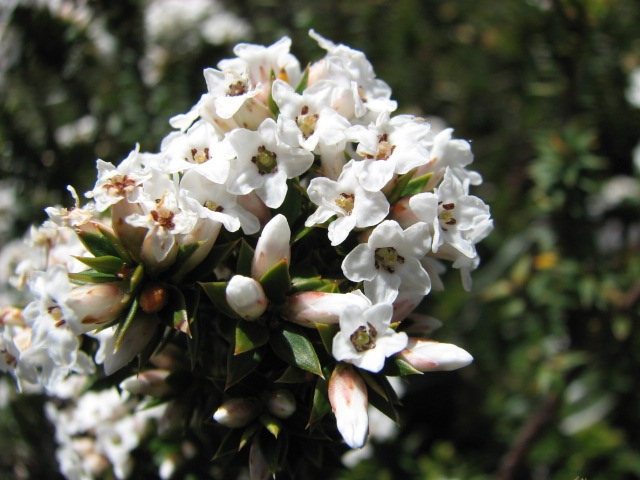Classification System: APG IV
Superregnum: Eukaryota
Regnum: Plantae
Cladus: Angiosperms
Cladus: Eudicots
Cladus: Core eudicots
Cladus: Asterids
Ordo: Ericales
Familia: Ericaceae
Subfamilia: Epacridoideae
Tribus: Epacrideae
Genus: Epacris
Species: Epacris breviflora
Name
Epacris breviflora Stapf, 1910
Distribution
Native distribution areas:
Continental:Australasia
Regional:Australia
Australia (Queensland, New South Wales, Victoria)
References: Brummitt, R.K. 2001. TDWG – World Geographical Scheme for Recording Plant Distributions, 2nd Edition
References
Primary references
Stapf, O., 1910. Bulletin of Miscellaneous Information, Royal Gardens, Kew 1910(7): 216 .
Links
Hassler, M. 2020. Epacris breviflora. World Plants: Synonymic Checklists of the Vascular Plants of the World In: Roskovh, Y., Abucay, L., Orrell, T., Nicolson, D., Bailly, N., Kirk, P., Bourgoin, T., DeWalt, R.E., Decock, W., De Wever, A., Nieukerken, E. van, Zarucchi, J. & Penev, L., eds. 2020. Species 2000 & ITIS Catalogue of Life. Published on the internet. Accessed: 2020 Apr 22. Reference page.
Govaerts, R. et al. 2020. Epacris breviflora in Kew Science Plants of the World online. The Board of Trustees of the Royal Botanic Gardens, Kew. Published on the internet. Accessed: 2020 Apr 22. Reference page.
International Plant Names Index. 2020. Epacris breviflora. Published online. Accessed: Apr 22 2020.
Tropicos.org 2020. Epacris breviflora. Missouri Botanical Garden. Published on the internet. Accessed: 2020 Apr 22.
Vernacular names
English: drumstick heath
Epacris breviflora, commonly known as drumstick heath, is a plant of the heath family, Ericaceae and is endemic to the south-east of the Australian continent. It is an erect shrub with egg-shaped leaves with a sharp-pointed tip and with clusters of white flowers arranged near the end of the branches. It grows in Victoria, New South Wales and the far south-east of Queensland.
Description
Epacris breviflora is an erect shrub which usually grows to a height of 0.5–1.0 m (2–3 ft) and has hairy young branches. The leaves are egg-shaped 4–7.5 mm (0.2–0.3 in) long and about 1.5–3.5 mm (0.06–0.1 in) wide. The leaves have a rounded base and a sharply pointed tip. The flowers are clustered in the axils of the upper leaves. There are 10 to 23 bracts at the base of the flowers and five sepals 3–4 mm (0.1–0.2 in) long. The petals are joined to form a white, bell-shaped tube 2–3 mm (0.08–0.1 in) long with five lobes on the end, 2.5–3.5 mm (0.098–0.14 in) long. The five stamens and the single style are mostly enclosed in the petal tube. Flowering is mainly in summer but flowers are usually present throughout the year. The fruit are capsules about 2 mm (0.08 in) long.[1][2]
Taxonomy and naming
Epacris longiflora was first formally described in 1910 by Otto Stapf and the description was published in Bulletin of Miscellaneous Information.[3][4] The specific epithet (breviflora) is derived from the Latin words brevis meaning "short"[5]: 708 and flos meaning "flower".[5]: 338
Distribution and habitat
Drumstick heath mainly occurs along the Great Dividing Range from far south-eastern Queensland to eastern Victoria, sometimes at lower altitudes subject to cooler temperatures. It grows in swamps and other damp places.[1][2]
References
Powell, Jocelyn M. "Epacris longiflora". Royal Botanic Garden Sydney. Retrieved 7 November 2017.
Ohlsen, Daniel. "Epacris longiflora". Royal Botanic Gardens Victoria. Retrieved 7 November 2017.
"Epacris breviflora". APNI. Retrieved 7 November 2017.
Stapf, Otto (1910). "Epacris heteronema Labill. and E. dubia Lindl". Bulletin of Miscellaneous Information. 7: 216–217. Retrieved 7 November 2017.
Brown, Roland Wilbur (1956). The Composition of Scientific Words. Washington, D.C.: Smithsonian Institution Press.
Retrieved from "http://en.wikipedia.org/"
All text is available under the terms of the GNU Free Documentation License


